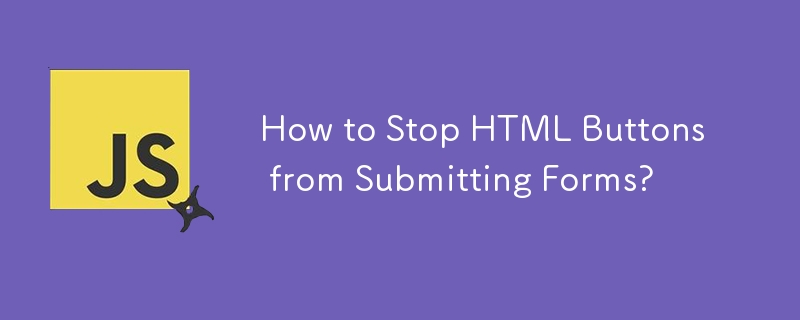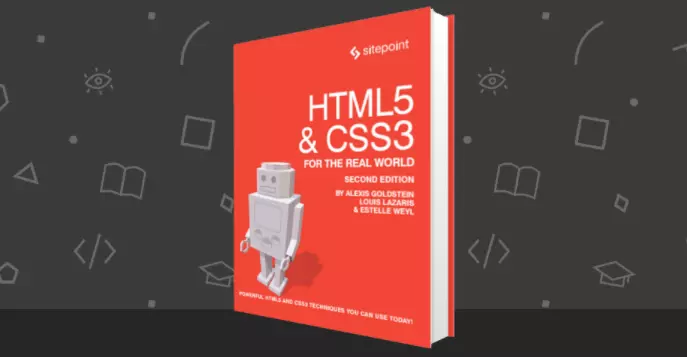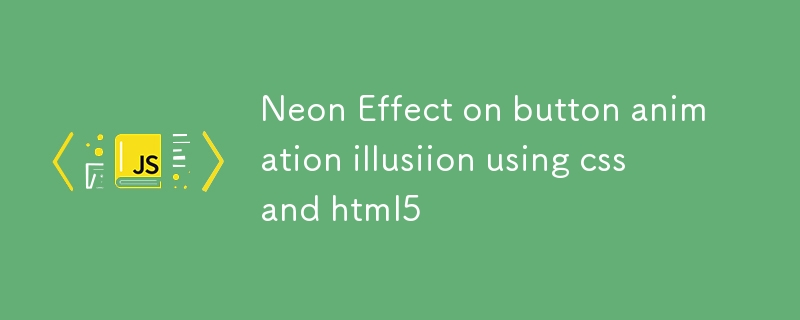Found a total of 10000 related content

How to Stop HTML Buttons from Submitting Forms?
Article Introduction:How to Prevent Form Submission from ButtonsProblem:In certain scenarios, such as using HTML5 button elements for adding or removing items, it's...
2025-01-02
comment 0
1071

Styling new HTML5 form elements effectively.
Article Introduction:To beautify HTML5 form elements, you need to deal with the differences in default style and browser. The specific methods are as follows: 1. Use ::-webkit-inner-spin-button and ::-webkit-outer-spin-button pseudo-elements to remove the up and down arrows; 2. Remove the default styles from input[type="range"] to customize the track and thumb part; 3. Use the native input[type="file"] and use the label simulation button to beautify the file upload control; 4. Use -we
2025-07-03
comment 0
222

How to disable a form input or button?
Article Introduction:To disable the input box or button in an HTML form, use the disabled property. 1. Just add the disabled attribute directly to HTML: or Submit. Both writing methods are valid, but HTML5 recommends using a valueless abbreviation. 2. Dynamic control can be used through JavaScript: set the disabled attribute of the element to true or false, such as document.getElementById("myInput").disabled=true;. 3. Optionally use CSS to beautify the disabled state: select by input: disabled, button: disabled
2025-08-01
comment 0
533

Using ARIA attributes with HTML5 semantic elements for accessibility
Article Introduction:The reason why ARIA and HTML5 semantic tags are needed is that although HTML5 semantic elements have accessibility meanings, ARIA can supplement semantics and enhance auxiliary technology recognition capabilities. For example, when legacy browsers lack support, components without native tags (such as modal boxes), and state updates need to be dynamically updated, ARIA provides finer granular control. HTML5 elements such as nav, main, aside correspond to ARIArole by default, and do not need to be added manually unless the default behavior needs to be overridden. The situations where ARIA should be added include: 1. Supplement the missing status information, such as using aria-expanded to represent the button expansion/collapse status; 2. Add semantic roles to non-semantic tags, such as using div role to implement tabs and match them
2025-07-07
comment 0
364

HTML5 Forms: Input Types (Part 1) - SitePoint
Article Introduction:Detailed explanation of HTML5 form input type and best practices
Core points
HTML5 forms introduce new input types, such as email, search, date, time, number, range, color, etc. These types provide user interface elements and native data verification functions that are more consistent with data types. Even in older browsers, these new input types work properly, except that they will appear as standard text fields by default.
The search input type (type="search") provides a search field to provide users with intuitive search site prompts. It usually comes with a built-in clear button and can be styled to match the browser or operating system
2025-02-18
comment 0
624

How do you change the playback speed of an HTML5 video?
Article Introduction:Yes, the HTML5 video playback speed can be adjusted through the playbackRate property of JavaScript, 1.0 is normal speed, faster than 1.0, slower than 1.0, 1. Call the function to set the speed value using the button or drop-down menu, 2. Get the video element and assign the value of playbackRate through getElementById, 3. Note that the browser supports a wide range but extreme speeds may affect the tone or be limited, and the typical range 0.5–2.0 is reliable and available.
2025-08-01
comment 0
149

Understanding HTML5 Media Autoplay Policy Changes
Article Introduction:The browser limits HTML5 media autoplay for user experience. Starting from Chrome 66, only silent automatic playback is allowed, and Safari and Firefox policies are stricter. Solutions include: 1. Mute by default and provide an unmute button; 2. Listen to the user to play a sound video after the first interaction; 3. When the iframe is embedded with the muted=1 parameter; 4. The mobile terminal needs to add the playsinline attribute. JS controls errors when playing, ensures that user interaction triggers and is compatible with promises from different browsers.
2025-07-04
comment 0
310

Building a Custom HTML5 Video Player Interface
Article Introduction:To create a custom HTML5 video player, you need to set up an HTML structure, implement control interaction and design a CSS style. 1. Set the infrastructure: Use tags and custom control areas, add necessary attributes to ensure compatibility; 2. Implement control interaction: control playback/pause through JavaScript listening button click events, and monitor the timeupdate event update progress bar and time display; 3. Design custom styles: use CSS to hide native controls and beautify the player's appearance, including style adjustments of buttons, progress bars and other elements.
2025-07-14
comment 0
528

How to build a form in HTML5?
Article Introduction:To add forms to a web page to collect user information, use the tags and attributes provided by HTML5. 1. Use tags to build a basic structure and include input types such as text, email, password and submit button; 2. Use and improve semantics and accessibility to ensure that each input is associated with tags and group related options; 3. Use required, minlength, maxlength and pattern attributes to achieve front-end verification, but it is necessary to note that the backend still needs to verify to ensure data security.
2025-07-23
comment 0
654

Designing Web Forms with HTML
Article Introduction:When designing a web form, you need to pay attention to four key points: structure, input type, verification and submission. 1. Use tags to wrap the form, specify action and method attributes, and use the matching to clarify the input items; 2. Select HTML5 input types such as text, email, password, etc. according to the needs to reduce errors; 3. Add verification on the front end such as required, minlength, and pattern to assist users in the correct input; 4. Place the submission button at the bottom to uniformly layout to avoid excessive content affecting the experience.
2025-07-23
comment 0
256

How to create a Bootstrap login form?
Article Introduction:Introduce the CSS and JS files of Bootstrap5 to build a basic environment; 2. Use containers, cards and form classes to build a centered and responsive login form structure, including email, password input box, check box and submit button; 3. Optionally add HTML5 form verification and enable Bootstrap verification style through JavaScript, combine responsive design to ensure mobile friendly, and can add prompt information or loading effects; 4. Finally, it is recommended to combine server verification, HTTPS, security mechanisms such as CAPTCHA, and customize the styles as needed to complete a safe and beautiful login form.
2025-08-01
comment 0
713

How to show subtitles or captions with an HTML5 video?
Article Introduction:To add subtitles or descriptions to HTML5 videos, elements need to be used. 1. Add in the tag, set kind, src, src, srclang, label and optional default attributes; 2. Prepare a text file that conforms to WebVTT format, including timestamps and corresponding text, and save it with .vtt as the extension; 3. Associate the elements with WebVTT files, such as adding English instructions and Spanish subtitles; 4. The user will see the subtitle button in the supported browser, and can select the language. The track with the default attribute will automatically play, and ultimately realize multilingual subtitles support and improve accessibility.
2025-08-02
comment 0
899

What are the various input types available in html forms and their uses?
Article Introduction:HTML forms support multiple input types to suit different data entry requirements. 1. Text input is used for basic data entry, such as text and password, and interaction can be enhanced through placeholder, maxlength, required and other attributes; 2. HTML5 introduces special input types such as email, number, date, tel, and url to improve data accuracy and usability; 3. Selection and operation controls include checkbox, radio, submit, and button, for multiple selection, single selection and submission operations; 4. Hidden is used to pass uneditable data, and file is used for file upload and can limit file types. When using it, you need to consider browsing
2025-07-04
comment 0
1003

The HTML `iframe` `allowfullscreen` Attribute
Article Introduction:allowfullscreen is a boolean property of elements in HTML5 that allows embedded content to enter full screen mode. 1. Its function is to enable the full-screen function in the iframe, such as clicking the full-screen button when playing videos; 2. By default, the browser will restrict full-screen operation for security reasons, so it needs to explicitly add this attribute; 3. When using it, you need to pay attention to the correct spelling, no assignment, and can be used in combination with other permission attributes; 4. If this attribute is not added, the iframe content will not be able to be full-screen, affecting the user experience.
2025-07-18
comment 0
893

Validating HTML5 markup using online tools and validators.
Article Introduction:The steps to verify HTML5 code normativeness include using tools such as W3CMarkupValidationService to check. 1. Open the W3C validator and enter the web page URL or paste the source code; 2. Click the "Check" button to start verification; 3. Check the error and warning content in the report and repair it item by item; 4. Based on the actual situation, determine whether to handle non-fatal errors; 5. Upload HTML files for verification during local development. Common errors include unclosed labels, discarded labels, unquoted attribute values, irregular custom attributes, and element nesting errors, which can be modified one by one according to the prompts.
2025-07-06
comment 0
907

What are common HTML5 validation errors?
Article Introduction:Common verification errors when newbies write HTML5 include unclosed tags, wrong format of self-closed tags, unquoted attribute values, use of discarded tags, and improper use of form attributes. 1. Structural tags need to be closed correctly; 2. Self-closed tags should be uniformly used in standard forms, such as not XML style; 3. It is recommended to always put quotes in attribute values ??to avoid special character problems; 4. Replace outdated tags such as CSS style; 5. Form elements should use type attributes such as email and required to ensure that the verification function takes effect. At the same time, note that the default type of button is submitted may cause unexpected submission.
2025-06-22
comment 0
901

How to clear localStorage in HTML5?
Article Introduction:There are two main ways to clear localStorage in HTML5. First, use localStorage.clear() to clear all data, which is suitable for situations where all storages under the current domain name need to be deleted at one time; second, use localStorage.removeItem('keyName') to delete the data of the specified key name, which is used to clear only specific data items. In addition, it can also be combined with event listening to realize automatic cleaning when page loading or user operations, such as performing deletion or binding logout button click event trigger clearing when page loading. It should be noted that localStorage data is persistent and will always exist if it is not cleared. Data is isolated between different domain names.
2025-07-09
comment 0
877

Manipulating Browser History with HTML5 History API
Article Introduction:HTML5's History API allows you to modify URLs without refreshing the page, improving the SPA experience. Its core method pushState() adds a new historical entry and replaceState() replaces the current entry. Both do not refresh the page but affects the behavior of the navigation buttons; for example, use pushState to update the URL when clicking the menu. The state parameter is used to save page status data and can be accessed through the window.onpopstate event, but this event is only triggered when the user clicks the forward/back button. In addition, HistoryAPI can only modify the path and query parameters of the same-origin URL, and cannot jump to other domain names. The server needs to configure a fallback to index.h
2025-07-12
comment 0
608



















